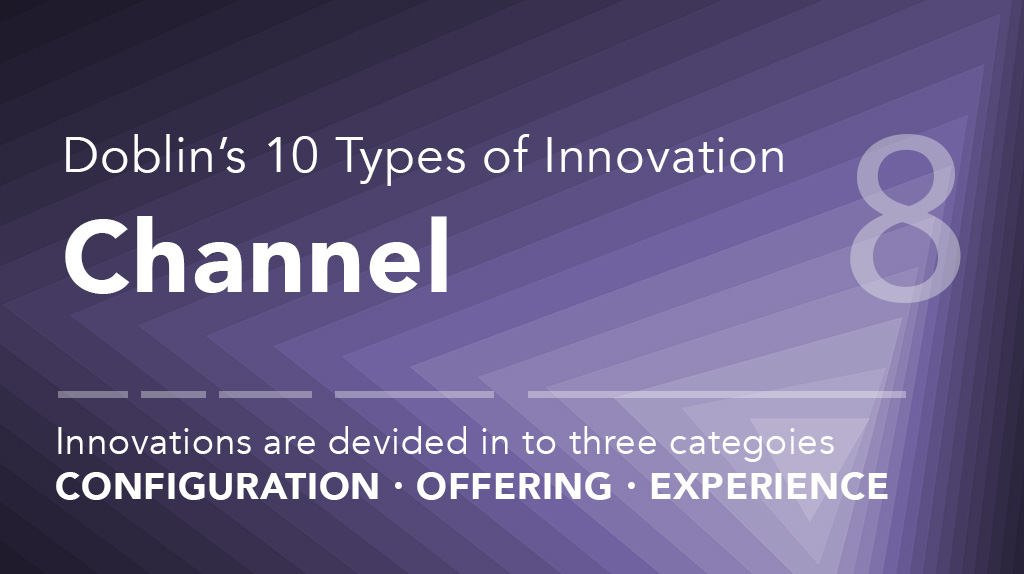Intro
In this series of posts, we will be inspecting Doblin’s 10 Types of Innovation, a popular framework for analyzing innovations in business developed by the Doblin Innovation Firm in Chicago. Innovations are divided into three categories: configuration, offering, and experience. Configuration focuses on the innermost workings of an enterprise and its business system, offering focuses on an enterprise’s core product or service, and experience focuses on customer-facing elements. In this post, we will analyze the second block in experience, channel innovation.
Definition
Channel Innovation is essentially about how you deliver your offerings to customers and users. Doblin defines channel innovation as:
“Channel innovations encompass all the ways that you connect your company’s offerings with your customers and users. While e-commerce has emerged as a dominant force in recent years, traditional channels such as physical stores are still important — particularly when it comes to creating immersive experiences. Skilled innovators in this type often find multiple but complementary ways to bring their products and services to customers. Their goal is to ensure that users can buy what they want, when and how they want it, with minimal friction and cost and maximum delight.”
A channel is the way that customers access products or services. Channel innovation revolves around all the different channels where customers and potential customers can find out about your company and its offering and the ways in which companies communicate and maintain that relationship. Channel innovation is far-reaching and often works in conjunction with other types of innovation. As a result, some may get confused in distinguishing between innovations, especially in the Experience grouping. For instance, people may confuse channel and network innovations — channel innovations are about how offerings are delivered and the touchpoint of the exchange, whereas network innovations are about who you work with to get an offering to market. Keeping these types unique can help companies properly analyze innovations.
Examples
Though e-commerce direct selling is the distribution channel that usually gets the most attention, there is a wide gamut of channel innovation types, for instance:
- Flagship Store – heavily branded retail stores that provide customers with a full and rich experience and showcase a firm’s brand and offerings
- Direct Selling – sell to customers directly online or through other means
- Pop-up Stores – create temporary, low-budget but high impact experiences for customers with a kiosk-like experience
- Subscription Model – Offering “curated” products that are sent to customers monthly
- Indirect Distribution – selling wholesale to agents or retailers who then distribute product for you
- Multi-level Marketing – utilize a third-party, unaffiliated sales force to sell products that they buy in bulk
For this blog post, we will focus on examples regarding flagship stores, direct selling, indirect distribution, and subscription models.
Flagship Store Examples
These signature venues are designed to give customers the full brand experience while showcasing a company’s offerings.
Nike is an American multinational corporation that designs and manufactures footwear, apparel, equipment, accessories, and services. Nike’s 50,000 square foot flagship NikeTown store in New York is the ultimate immersive shopping experience, allowing customers to try out Nike products while on treadmills or playing basketball and football and providing analysis with the help of motion-tracking cameras. As a result, Nike is able to pull together all aspects of its brand from its athletic wear to its sports technology, as well as utilize promotion by pulling appearances from its vast network of sports stars.
Lego is a Danish toy production company best known for their Lego-brand toys and theme parks. Lego recently opened their largest retail store in London, with life-sized models and a “mosaic portraits” system where participants can build Lego mosaics of their portraits after having their photo taken in a special booth. The store promises an immersive experience for Lego fans of all ages and reinforces Lego’s brand as more than just that of a toy.
Samsung is a South Korean multinational conglomerate that operates in multiple industries, but is best known in the US for their consumer electronics. Samsung 837 is Samsung’s three-story flagship New York store that lets visitors find out everything Samsung has to offer while utilizing its massive screen for events and livestreaming. Samsung 837 is unique among flagship stores because nothing is for sale — it is a space wholly dedicated to being an experience.
Direct Selling
These channel innovations find various ways to reach consumers directly without a middleman.
Dow Corning is an American multinational corporation that manufactures industrial materials like silicone. In 2002, Dow Corning launched Xiameter, their web-based sales channel, offering a no-frills experience for cost-conscious buyers who didn’t need technical support or advice. While sales through intermediaries like sales agents had been the norm, this new sales channel greatly reduced the need for them, in some cases eliminating them entirely.
The New York Public Library is the second largest public library in the United States and the fourth largest in the world. The NYPL created Insta Novels, offering digitized versions of literary classics that are posted through Instagram Stories. As a result, the NYPL was able to quickly and efficiently connect with a new generation of readers, offering a painless way for them to engage with content.
Martha Stewart Living Omnimedia
Martha Stewart Living Omnimedia is a diversified media and merchandising company founded by television personality Martha Stewart. The company has utilized various channels in order to promote and sell Martha Stewart’s brand and products directly to consumers, including through magazines and publishing, television, radio, and e-commerce. Through these various channels, the company has essentially created an easily accessible ecosystem that has cemented Matha Stewart as one of the few celebrity brand names with lasting power in the home goods and lifestyle space.
Indirect Distribution
These channel innovations utilize intermediaries who distribute products on behalf of companies.
Nespresso is an operating unit of the Nestle Group that sells coffee machines and single-use coffee capsules. While Nespresso takes advantage of multiple sales channels, Nespresso has partnerships with and sells B2B to hospitality-related companies — hotel chains like Ritz-Carlton and Hyatt, airports, and airlines like Lufthansa and Qantas. This exposes many consumers who would otherwise not be interested in Nespresso to their product, while reinforcing their brand by aligning it with those of luxury and high-end companies.
McDonald’s is an American fast food company founded in 1940 and is one of the largest fast food chains in the world. Like many fast food restaurants, McDonald’s operates through franchises who pay a fee to use the McDonald’s brand and sell McDonald’s products, the latter of which franchisees purchase directly from McDonald’s itself. This franchising model helps fast food companies expand rapidly with minimized risk and allows McDonald’s to focus on production, distribution, and marketing.
Subscription Model
These channel innovations revolve around packages of curated goodies sent periodically to subscribers.
Dollar Shave Club is an American company that delivers razors and other personal grooming products to customer by mail. While razor blades have traditionally been a high-margin product (as seen with Gillette), Dollar Shave Club reduces the cost of each blade by having people subscribe to an automatic blade delivery service. While they earn less money per blade, they have a steady, predictable revenue that has inspired many others to develop subscription box offerings.
HelloFresh is a German publicly-traded company that is the number one provider of meal-kits in the United States. HelloFresh boasts easy and healthy recipes, high-quality ingredients, affordability, and ease of cancelling/skipping orders. While many subscription box offerings revolve around non-perishable items for ease of logistics and transportation, HelloFresh innovates by providing perishable foods and convenience to customers.
Techniques to Develop Channel Innovation
Because channel innovations can be so diverse, a good place to start can be to observe competitors and parallel markets. How are competitors reaching their customers? If all of your competitors are using the same channels, what’s a new one that your company can forge? Are there any new or novel channel innovations happening in parallel markets that can be adopted into your company? Are there any new or novel channel innovations going on in completely unrelated markets or companies that can be adapted to fit your company?
All of these questions can only be answered once you understand your core offering, brand, and customer expectations. Channel innovations are particularly context-sensitive depending on the industry and customer habits, and thus the better you know your overall strategic goals the better chance of success you’ll have with a channel innovation. Do you have a product line that customers must interact with to truly appreciate? A flagship store may be best. Are you trying to send a quick, high-impact message to solidify your brand? A pop-up shop can be a low-cost way to generate interest. Have you garnered enough brand loyalty to and are looking to offer customers more? Direct selling or subscription services may be an option.
When thinking about channel innovations, core offerings usually take the sole focus, but it’s important to consider complementary products or offerings as well. Channel innovations can also result as a byproduct of other innovations. For instance, the invention of the automobile transformed the logistics, delivery, and fulfillment aspects of many industries, especially perishable foods like milk and ice. We see this also happening today, with drones revolutionizing the way emergency medical supplies can be delivered to places that are hard to get to.
Impact
Channel innovations can have a huge effect on company’s bottom lines. Many channel innovations, like direct selling through e-channels, can reduce overhead costs while maximizing margins and cost advantage. Other channel innovations, like indirect distribution, can alleviate wasted time or effort by outsourcing sales, allowing a company to focus on what it does best. Innovations like subscription boxes will sacrifice some profitability in favor of a predictable, steady stream of income, which can make a company’s balance sheets more enticing to outside investors.
Some channel innovations are not cost-effective — in fact, quite the opposite. Building a flagship store is an expensive and time-consuming process. Flagship stores are usually in established and trendy metropolitan areas, meaning sky high rent. Pop-up shops can be expensive when considering return on investment — by nature, the shop likely won’t move that much merchandise. However, what these channel innovations lack in revenue generation they make up for by reinforcing a company’s brand in consumers’ heads. These innovations focus on how to connect your company’s offerings with your buyers and rewards them with an experience.
Conclusion
Channel innovations focus on new ways to connect with customers that more effectively drive sales, enhance margins, or increase exposure and positive associations with a company’s brand. They can often be ported from company to company or industry to industry, but can only be successful if a company has an intimate understanding of its customers and brand. The best channel innovations revolutionize our systems and completely change the way we do things. As technology improves along with our ability to understand consumers, channel innovations will continue to develop and make our lives better.



